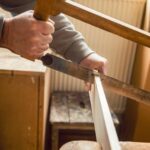Are you tired of finding your beloved woodwork scratched and damaged by your furry feline friend? If you are wondering how to keep cats from clawing woodwork, you have come to the right place. Understanding the reasons behind a cat’s need to claw is the first step in addressing this behavior and finding effective solutions.
Cats have a natural instinct to scratch and claw surfaces for several reasons, including stretching their muscles, marking their territory, and maintaining their claws. In this article, we will explore the various methods and techniques to help you prevent your cat from damaging your woodwork while still allowing them to satisfy their natural scratching instincts.
By understanding why your cat feels the need to claw, you can better address this behavior and provide alternative surfaces for scratching that will protect your woodwork. From choosing the right scratching posts and pads to using deterrents and creating a positive scratching environment in your home, there are numerous strategies available to keep both your cat and your woodwork happy.
Choosing the Right Scratching Posts and Pads
When it comes to preventing cats from clawing woodwork, choosing the right scratching posts and pads is essential. Cats have a natural instinct to scratch and mark their territory, so providing them with appropriate surfaces for scratching is crucial in redirecting this behavior away from your furniture and woodwork.
The first step in choosing the right scratching posts and pads is to consider your cat’s preferences. Some cats prefer vertical scratching posts, while others may prefer horizontal scratching pads. It’s important to observe your cat’s scratching habits to determine their preference, as this will increase the likelihood that they will use the chosen alternative.
Additionally, you should consider the material of the scratching post or pad. Cats often prefer rough textures that allow them to fully extend their bodies while scratching. Sisal, cardboard, and wood are popular materials for scratching surfaces. Investing in high-quality, durable scratching posts and pads will ensure that they withstand regular use by your cat.
Finally, consider the size and stability of the scratching post or pad. The ideal scratching surface should be tall enough for your cat to stretch fully and stable enough that it won’t topple over during vigorous scratching sessions. By taking these factors into account when choosing a scratching post or pad, you can effectively provide your cat with an alternative outlet for their natural scratching behavior while keeping your woodwork safe from damage.
Overall, understanding your cat’s preferences and providing them with suitable scratching alternatives is key in preventing them from clawing woodwork. With the right choice of scratching posts and pads, you can create a positive environment for your cat’s natural behavior while maintaining the integrity of your home furnishings.
Training Your Cat to Use the Scratching Posts
Training your cat to use scratching posts is a crucial step in preventing them from clawing your woodwork. It’s essential to understand that cats have a natural instinct to scratch in order to sharpen their claws and mark their territory. Therefore, providing appropriate scratching surfaces is key in redirecting this behavior.
When it comes to choosing the right scratching posts, consider the material, height, stability, and texture. Cats prefer sturdy posts that allow them to fully stretch their bodies while scratching. Additionally, different cats have different preferences when it comes to texture, so consider offering a variety of materials such as sisal, carpet, cardboard, or wood.
Once you have selected the appropriate scratching posts and pads, it’s time to train your cat to use them. Placing the posts in strategic locations where your cat tends to scratch is important. You can also encourage your cat to use the posts by enticing them with toys or treats near the scratching surfaces. Positive reinforcement such as praise and treats when they use the posts will also help in training them.
Providing alternative surfaces for scratching is also helpful in training your cat. Covering or protecting the woodwork they tend to claw with double-sided tape or plastic sheets can deter them from using those areas. This reinforces the idea that there are specific surfaces meant for scratching. With consistency and patience, your cat can be trained to minimize damage to your woodwork.
| Understanding | Reasons Behind a Cat’s Need to Claw |
|---|---|
| Choosing | the Right Scratching Posts and Pads |
| Providing | alternative Surfaces for Scratching |
Providing Alternative Surfaces for Scratching
Cats have a natural instinct to scratch and mark their territory, and as much as we want to prevent them from damaging our woodwork, it is important to understand the reasons behind this behavior. One way to keep cats from clawing your woodwork is by providing alternative surfaces for them to satisfy their scratching needs. Here are some recommendations on how to achieve this:
- Scratching posts: Choose a variety of scratching posts with different textures and materials such as carpet, sisal rope, or cardboard. Place them in different areas of your home where your cat likes to scratch the most.
- Scratching pads: Consider using scratching pads that can be laid flat on the floor or hung on a wall. These pads provide an alternative surface for your cat to scratch and are especially helpful if your cat prefers horizontal scratching.
It is important to consider your cat’s preferences when selecting alternative surfaces for scratching. Some cats may prefer vertical scratching posts, while others may enjoy horizontal surfaces. By providing a variety of options, you can encourage your cat to use these designated areas instead of clawing at your woodwork.
In addition to scratching posts and pads, you can also incorporate other alternative surfaces such as cardboard boxes or tree bark for outdoor cats. Offering a diverse range of materials and textures will help fulfill your cat’s natural urge to scratch while protecting your woodwork.
By understanding the reasons behind a cat’s need to scratch and providing appropriate alternative surfaces, you can effectively prevent them from damaging your woodwork. Remember that patience and consistency are key when training your cat to use these designated areas for scratching.
Using Deterrents to Discourage Clawing
When it comes to preventing your cat from clawing your woodwork, using deterrents can be an effective strategy. There are various types of deterrents available that can help discourage your cat from scratching surfaces in your home. One popular option is using double-sided tape on the areas where your cat tends to scratch. Cats typically do not like the sticky sensation of the tape on their paws, which can deter them from clawing at the woodwork.
Another useful deterrent is a citrus-based spray. Cats generally dislike the scent of citrus, so spraying a citrus-scented solution on the woodwork can discourage them from scratching those surfaces. Additionally, there are commercial products specifically designed to repel cats from certain areas, such as bitter apple sprays or motion-activated devices that emit a harmless burst of air when they detect movement.
It’s important to note that while deterrents can be effective in many cases, they should be used in conjunction with other strategies for preventing clawing behavior in cats. It’s also essential to ensure that you provide alternative surfaces for scratching and create a positive scratching environment in your home. By combining these different approaches, you can effectively discourage your cat from clawing at your woodwork and maintain a harmonious living environment for both you and your pet.
| Using Deterrents | Benefits |
|---|---|
| Double-sided tape | Deters cats with its sticky texture |
| Citrus-based spray | Repels cats with its unpleasant scent |
| Commercial products | Offers options such as bitter apple sprays and motion-activated devices |
Regularly Trimming Your Cat’s Nails
Trimming your cat’s nails is an important aspect of preventing them from clawing at your woodwork. Not only does it keep their nails at a manageable length, but it also reduces the damage they can cause when scratching. Here are some tips on how to trim your cat’s nails effectively:
- Use cat-specific nail clippers to avoid splintering or crushing the nail.
- Find a quiet and comfortable space for both you and your cat to minimize stress during the process.
- Gently hold your cat’s paw and press on the pad to extend the claws before carefully trimming the sharp tips. Be cautious of the quick, which contains blood vessels and nerves.
- Reward your cat with treats and praise after each successful nail-trimming session to create a positive association with the process.
Regular nail trims should ideally be done every 1-2 weeks, depending on your cat’s activity level and the rate of nail growth. If you are unsure about how to trim your cat’s nails or if your cat becomes extremely distressed during the process, consider seeking help from a professional groomer or veterinarian.
Moreover, maintaining short nails not only prevents damage to woodwork but also reduces the risk of injury for both you and your furniture. Additionally, it promotes good hygiene, as long nails can become dirty or snagged on surfaces, leading to infection or injury for your furry friend. By incorporating regular nail trims into your cat care routine, you can significantly decrease their urge to claw at woodwork while also promoting their overall well-being.
Seeking Professional Help for Persistent Clawing Behavior
Recognizing When to Seek Professional Help
If you have tried various methods to prevent your cat from clawing the woodwork in your home, but they continue to do so persistently, it may be time to seek professional help. Persistent clawing behavior could be a sign of an underlying issue such as stress, anxiety, or medical problems. If the deterrents and training techniques have not been effective, consulting with a veterinarian or animal behaviorist can provide valuable insight into your cat’s behavior.
Working With a Veterinarian
A veterinarian can conduct a thorough examination of your cat to rule out any potential medical reasons for their scratching behavior. They can also provide advice on ways to address any underlying health issues that may be contributing to the problem. For example, if your cat has arthritis or other physical ailments that make scratching uncomfortable, the vet can recommend treatment options to alleviate their discomfort.
Consulting With an Animal Behaviorist
An animal behaviorist can offer expertise in understanding your cat’s psychological needs and motivations for scratching woodwork. They can assess your cat’s environment and interactions within the home to identify any stressors that may be causing the unwanted behavior. With their guidance, you can develop a comprehensive plan to modify your cat’s behavior through positive reinforcement and environmental enrichment.
By seeking professional help for persistent clawing behavior, you can gain a better understanding of your cat’s specific needs and address any potential underlying issues that may be contributing to their scratching habits. Remember that every cat is unique, so finding the right approach tailored to your feline companion is key in resolving this challenging behavior.
Creating a Positive Scratching Environment in Your Home
Cats have a natural instinct to scratch, so it’s important for cat owners to create a positive scratching environment in their home. By understanding the reasons behind a cat’s need to claw and providing them with the right resources, you can prevent your furry friend from damaging your woodwork.
Understanding Your Cat’s Instincts
Before addressing the issue of your cat clawing at woodwork, it’s important to understand why they do it in the first place. Scratching helps cats shed the outer sheath of their nails, mark their territory, and stretch their muscles. By recognizing these instincts, you can then work towards providing suitable outlets for this behavior.
Choosing Suitable Surfaces
One effective way to keep cats from clawing woodwork is by providing them with appropriate scratching posts and pads. Make sure to choose posts that are tall enough for your cat to fully stretch out when scratching, as well as sturdy enough to withstand their claws. It’s also beneficial to have multiple scratching surfaces throughout your home, especially near areas where they tend to claw the most.
Cat-Friendly Deterrents
In addition to offering suitable scratching surfaces, using deterrents can also help prevent cats from clawing woodwork. Double-sided tape or sticky vinyl placed on the affected areas can dissuade your cat from clawing there again. Additionally, citrus scents or aluminum foil can be off-putting for cats and discourage them from using certain surfaces for scratching.
By following these tips and recommendations on how to keep cats from clawing woodwork, cat owners can create a positive environment in their home that satisfies their feline friends’ natural instincts while preserving their furniture and woodwork.
Conclusion
In conclusion, living harmoniously with your cat and your woodwork is possible by understanding their natural instinct to claw and providing them with suitable alternatives. By selecting the right scratching posts and training your cat to use them, you can prevent damage to your furniture and maintain a happy relationship with your pet. Additionally, offering alternative surfaces for scratching and using deterrents when necessary can further discourage clawing behavior.
Regularly trimming your cat’s nails is also essential in preventing damage to your woodwork. Seeking professional help for persistent clawing behavior is important if despite all efforts, the problem persists. Creating a positive scratching environment in your home by rewarding good behavior and providing engaging toys can also contribute to a peaceful coexistence between you, your cat, and your beloved woodwork.
By following these tips on how to keep cats from clawing woodwork, it is possible to live in harmony with our feline friends without sacrificing our furniture. With patience, understanding, and proper training, it is possible to have both happy pets and intact woodwork in our homes.
Frequently Asked Questions
How Do I Stop My Cat From Scratching My Woodwork?
To stop your cat from scratching your woodwork, you can start by providing alternative scratching surfaces like scratching posts or pads. You can also use deterrents like double-sided tape or citrus sprays on the woodwork to make it less appealing for your cat.
How Do You Protect Wood From Cat Claws?
Protecting wood from cat claws can be done by trimming your cat’s nails regularly. Another option is to use plastic nail caps that cover the claws and prevent them from causing damage to the wood surfaces. Providing enough scratching posts can also redirect your cat’s scratching behavior away from the wood.
How Do You Protect Wood Trim From Cat Scratches?
If you want to protect wood trim from cat scratches, try using vinyl nail covers or applying a clear plastic film over the trim. Training your cat to use scratching posts instead of the trim can also be effective in preventing damage. Additionally, using deterrents like aluminum foil or citrus sprays on the trim can help discourage scratching behavior.

Hi everyone! I’m a woodworker and blogger, and this is my woodworking blog. In my blog, I share tips and tricks for woodworkers of all skill levels, as well as project ideas that you can try yourself.





